Gwonbeop
| Gwonbeop | |
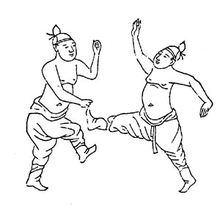 | |
| Korean name | |
|---|---|
| Hangul | 권법 |
| Hanja | 拳法 |
| Revised Romanization | Gwonbeop |
| McCune–Reischauer | Kwŏnpŏp |
Kwonbeop is the term for unarmed methods in Korean martial arts as developed in the Joseon era (15th to 19th centuries). It is the Korean rendition of the Chinese Quan fa (拳法).
Early development
Destruction of the Korean palace and its libraries in 1126 as well as the Mongols invasion in 1231 and the subsequent Mongol domination of Korea (Yuan Dynasty 1231-1356) has eliminated any literary history of Korea prior to that time. As a result, no first-hand accounts of the origins of Gwon Beop practices in Korea is known. However, in 1145, King Injong (r. 1112-1146) ordered a Confucian scholar, KIM Bu-sik, to compile the Samguk Sagi (lit. "History of the Three Kingdoms"). Some 100 years later a Buddhist monk, Iryeon, compiled the Samguk Yusa (lit.: "Memorabilia of the Three Kingdoms").[1] Both works indicate that militant attitudes between and among the three major States of the Three Kingdoms Period (37 BCE - 660 AD) resulted in each nation developing an institution for training its warriors in Military Science. While the term Gwon Beop was not used, cadets of the Pyong Dang ("educational institute") in the Goguryeo kingdom learned punching, strikes and kicks (K. Ji Leu Ki Beop), while cadets of the Silla Kingdom learned Chil Kuk (kicks) and Soo Bak (punches and strikes). In the Kingdom of Baekje, "empty-hand fighting" (K. Soo Sool) was included in the training. Consolidation of the Korean peninsula under Silla in 668 enhanced the Silla approach to hand-to-hand combat over its neighbors, though continued and repeated conflicts provided opportunity to refine and enhance the material. Infrequent references to Soo Bak contests indicates that contests in unarmed combat, often with considerable wagering by the audience, occurred on holidays and other special occasions up until the invasion and dominance of Korea by Mongols (1231 - 1392)[2]
Later development
With the end of Mongol dominance, predations and incursions by Wa-Ko, coastal raiding forces of mixed nationalities, provided the Korean administration with some rationale for rebuilding Korean Military installations and units. However, such efforts were undercut by Neo-Confucian thought that disparaged Military practices in favor of leadership by scholars and bureaucrats. As a result, Korea was unprepared for the invasion by Japanese armies in 1591, intent on using Korea as an approach for conquering China. Known as the "Imjin Waerum" (Japanese invasions of Korea), the Japanese advance easily over-ran the Korean army and was stopped only by the Ming Army and the patriotic efforts of Korean nationals formed into "righteous armies" (K. Uibyeong; 위병). In September, 1593, King Seonjo of Joseon (1567-1608) established the Hunlyun Dokam (Royal Military Training Agency). At the encouragement of the Ming General Liu, T’ing, the Korean Prime Minister, Yu Song-Nyong, sought to reorganize the Korean army into a highly structured and versatile organization. His manual for this effort was the Jin Xiao Shin Shu or “Manual of New Military Tactics” written by General Qi Jiguang (1528-1588) and published in 1567. Chapter 14 of this manual addressed 32 methods of using the body for hand-to-hand combat, which General Qi stated was of little use on the battlefield but which contributed to the confidence and conditioning of his soldiers. These 32 methods, gleaned from an examination of 16 major fighting systems in Ming China, were recorded in 32 brief poems, while the practical use and applications were left to the Military Training cadre.
Following the end of hostilities in 1598, the Korean government sought to record all material that they had found useful, rather than adopt the manual of General Qi in its entirety. As a result, the Muyejebo sokjip (무예제보 속집, 武藝諸譜續集, “Martial Arts Illustrations”) by Choe Gi-nam (Hangul: 최기남, Hanja: 崔起南) was published in 1610. Ordered by King Seonjo, the work was compiled by one of the king’s military officers, HAN Kyo, and consisted of 6 fighting systems. These included the kon bong (long staff), dung pae (shield), nang sun (multi-tipped spear), jang chang (long spear), dang pa (triple-tip spear) and the ssang soo do (two-handed saber). Around the time this work was to be published, four volumes of a Japanese martial arts manual were added as well, leading to the compilation of the Muyejebo Beonyeoksokjip (무예제보번역속집, 武藝諸譜飜譯續集) in 1610. This latter work included some 30 methods of unarmed combat.
During the reign of King Yeongjo of Joseon (1694-1776) the Muyejebo was revised and supplemented with 12 additional fighting methods by Prince Sado who originated the term Shippalgi (“Eighteen Fighting Methods”). Though often confused with Chinese practices of the same name and later 20th Century practices, the term coined by Crown Prince Sado, a shortened form of Bonjo Muye Sip Pal Ban (본조무예십팔반, 文章武藝十八般, "18 Martial Arts Classes [of the Yi Dynasty]"), identified this Korean collection of 18 fighting systems. Gwon Beop made a reappearance in this work, albeit in a heavily modified state. Of the original 32 methods cited by General Qi,only some 19 methods were identified. Another 14 methods, for a total of 33 methods, were included in the revision but may or may not have been related to the material of General Qi's Boxing Classic. This revised publication was titled the Muyesinbo (무예신보, 武藝新譜, “Martial Arts New Illustrations”) and published in 1759.
During the reign of King Jeongjo of Joseon (1752-1800) the Muyesinbo was revised by PARK Je-ga and LEE Duk-moo beginning in 1790. Supplemented with 6 additional fighting skills, these "new" methods were little more than dismounted methods such as spear, sword and flail which had been modified for execution from horseback. Gwon Beop material was also further modified with the addition of material performed between partners. The material was intended to reflect a combat format in deference to Neo-Confucian thought, by having partners use matched methods which would only produce a "stalemate" rather than a victory of one partner over another. Though ideologically satisfactory, the practice rapidly fell into disuse for its lack of practical combat effectiveness. This revised publication is titled the Muyedobotongji (무예도보통지, 武藝圖譜通志, “Comprehensive Illustrated Manual of Martial Arts”) and was published in 1795.
Modern development
The second half of the 19th Century saw a trend towards adopting Western practices and abandoning long-standing traditions. Bolt-action rifles, revolvers and breech-loading artillery not only caused a change in tactics but the very role of the individual fighter. Casualties of this trend were such "cold weapons" as spears, cudgels and sticks, as well as the bow-and-arrow methods. However, the practice of using hand-to-hand combat training as a method of conditioning and building confidence still carried merit. Furthermore, both the Russo-Japanese War (1904) and World War I, demonstrated that the future of warfare lay with frequent encounters among small units rather than between waves of advancing troops. Each country sought to identify effective fighting material with which the individual fighter could protect himself in the absence of a weapon. Korea's efforts were quickly eclipsed by Japan which subjugated Korea (1910-1946) and imposed its customs and practices on the Korean population, especially in the urban areas. Conservative and nationalist elements had long made a practice of retiring to the mountains and rural areas to maintain their practices and beliefs, but in the urban areas such Japanese practices as Kendo, Judo, and Aikido were adopted and given Korean names. In addition, Korean Education as well as Military training of enlisted men and officers focused on Japanese practices and thinking. In the years following the Second World War and the Korean conflict (1950-1953), Korean administrators whose education and training included Japanese practices sought to build a Korean Martial heritage by renaming and reshaping these practices. In this way Japanese Shotokan and Shudokan Karate became the foundation for Taekwondo and Tangsoodo. Further complicating the situation was the indiscriminate use of Korean and Japanese terms between and among these practices.
Korea also had a history of regular trade and exchange across the Yellow Sea with northeastern China generally, and Shandong province in particular. Long a location associated with Military Science and fighting arts, Shandong province had imparted to Korea a variety of arts over the years. Liang Xue Xiang (1780-1860) was mentioned prominently by the Korean Branch of the Mei Hua Tang Lang (梅花螳螂 : méi huā táng láng ; 매화당랑) as the "creator of the Plum Flower Branch of Northern Praying Mantis, while Lin Ping Jiang, an emigre of the 1940's is known to have come from Shandong province to teach Praying Mantis in the Seoul area. Other Chinese Boxing traditions such as Northern Long Fist (Changquan), Tam Tui (Tán Tuǐ), Baqua Chang (Baguazhang) and Hsing-Yi Boxing (Xingyiquan), all found their way to Korea. With the end of the Chinese Civil war in 1948, ex-patriot practitioners of Southern Chinese Boxing traditions also came to Korea bringing Southern Long Fist and Southern Preying Mantis as well. As in the case of Japanese practices, the introduction of Chinese arts introduced a plethora of new terms, or new meanings for old terms, such as Kung Fu, Sip Pal Ki, Chuan Fa, Chin Na and Shaolin. And as with the Japanese materials, terms and concepts were often used inaccurately, if indiscriminately. During the 1970's and 1980's, a variety of efforts were made to develop a definitive tradition which would represent Korea's Military past. Typically the result was an admixture of material from disparate practices across Korea, cobbled together for political and commercial motives more than anything else.
In 1969, a Sib Pal Gi school was opened by KIM Kwang Seok (김광석) who had begun studying Sib Pal Gi under YUN Myeong Deok (윤명덕) in 1951, initiating a new chapter in Korean Martial Arts history. YUN Myeong Deok had studied Sib Pal Gi in the conservative rural areas of Korea where much of the original material had been preserved. Between 1985 and 2002 KIM Kwang Seok published four books concerning the nature and practice of the Bonjo Muye Sip Pal Ban ("18 Martial Arts Classes of the Yi Dynasty") identified by Prince Sado in 1759. These works included a focused study of the Gwon Beop material as well. KIM Kwang Seok's writings introduced a new era of research and practice into traditional Korean Martial traditions. Research into, and practice of, traditional Gwon Beop methods continues with at least four entities proceeding directly from Kim's original work.
Contents and structure
Ji Xiao Xin Shu ("Manual of New Military Tactics")
The following is a listing of the original 32 Boxing Methods identified by General Qi Jiguang in his training manual - Ji Xiao Xin Shu (紀效新書), Chapter 14, also sometimes identified as “The Boxing Canon”. Among the arts General Qi states that he examined for his material are well-known practices such as Taiso Chang Chuan ( "Zhao Taizu Long Fist"), Liu Ho Chuan ("Six-Step Boxing") and Hou Chuan ( "Monkey Boxing"). General Qi also identified “among the best contemporary styles are the "Thirty-six Posture Locking Form", "24 Throws Pat on Horse", "Eight Evasive Maneuvers", “Twelve Postures Closing Boxing”, “Lu Hungs Eight Throws”.....”Cotton Changs’ Close Boxing”, “LI Pan-tien of Shantung Leg Techniques”, “Eagle Claw Wang’s Grappling Techniques”, “Thousand Falls Chang’s Falling Techniques”, “CHANG Po-chings’ Striking Techniques”. Having been disappointed with the poor quality of conscripts coming from China's cities, General Qi drew heavily from the rural areas for the hardiness of its farmers. As a result, many allusions to training, and training methods, mentioned in General Qi's writing use non-technical, even fanciful titles and terms which could be appreciated by an illiterate rural conscript. This format was continued through the Joseon Dynasty and some examples of the Korean equivalent for Chinese labels are given in the following list. As was the custom for such writing during the Ming Dynasty, each method is characterized by a brief poem structured according to the manner of those times and identified with a title which captured the essence of the fighting method. (“Herein we have illustrated the postures and annotated them with aphorisms to enlighten future students.”) An example of this is provided at the end of the listing.
- Casually Hitch-up your Clothes: Identifies the need for both mental and physical preparation for an encounter
- Golden Rooster: Stand on One Leg: Identifies the Importance of Balance relative to terrain[n 1]
- The Spy Techniques (Scouting Horse Posture Tammase (탐 마 세) 探 馬 勢): Identifies the nature of a "Host" forward hand and a "Guest" rearhand
- Stretch out the Whip
- Seven Star Strike: Identifies the nature of "Inside" striking techniques
- Mount the Dragon Backwards (Falling and Riding the Dragon Posture Dokiryongse)
- Suspend the leg as empty bait False Prey Posture Hyunkak Huheese (현 각 허 이 세) 顯 脚 虛 餌 勢
- The Qiu Liu Posture
- Lower Jabbing Position
- Ambush Crouch Posture (Ambushing Posture Maebokse)
- Cast the Body Forward
- Taking the Elbow in Hand Posture
- One Instant Step (Drizzling Walk Posture Ilsahpbose (일 삽 보 세) 一 霎步 勢)
- Capture and Grab Stance
- Mid-Guard Posture (Middle Four Levels Posture Joongsapyeongse (중 사 평 세) 中 四 平 勢)
- Crouched Tiger Posture (Prone Tiger Posture Bokhose (복 호 세) 伏 虎 勢)
- High Guard Posture (High Four Levels Posture)
- Reverse Stabbing Position
- Well-railing Four-wise Balanced
- Ghost Kick
- Finger Opposition Posture
- Beast Head Position
- Spirit Fist
- Single Whip (Single Whip Posture Yodanpyunse (요 단 편 세) 拗 單 鞭 勢)
- Coiled Leg Method
- Yang-Facing Hand
- Wild Goose Wings (Goose Wing Posture Ahnshi Chukshinse)
- Straddling Tiger Posture (Straddling Tiger Posture Koahose)
- Joining Together the Luan Elbows
- Cannonball against the Head
- Synchronize the Luan Elbows
- Banners and Drums Posture
 Ji Xiao Xin Shu; Chapter 14 (Boxing Canon) 1st page of commentary
Ji Xiao Xin Shu; Chapter 14 (Boxing Canon) 1st page of commentary Ji Xiao Xin Shu; Chapter 14 (Boxing Canon) 2nd page of commentary
Ji Xiao Xin Shu; Chapter 14 (Boxing Canon) 2nd page of commentary Ji Xiao Xin Shu; Chapter 14 (Boxing Canon) 3rd page of illustrations and accompanying commentary
Ji Xiao Xin Shu; Chapter 14 (Boxing Canon) 3rd page of illustrations and accompanying commentary Ji Xiao Xin Shu; Chapter 14 (Boxing Canon) 4th page of illustrations and accompanying commentary
Ji Xiao Xin Shu; Chapter 14 (Boxing Canon) 4th page of illustrations and accompanying commentary Ji Xiao Xin Shu; Chapter (Boxing Canon) 9th and last page of illustrations and accompanying commentary
Ji Xiao Xin Shu; Chapter (Boxing Canon) 9th and last page of illustrations and accompanying commentary Ji Xiao Xin Shu; Chapter 14 (Boxing Canon) 8th page of illustrations and accompanying commentary
Ji Xiao Xin Shu; Chapter 14 (Boxing Canon) 8th page of illustrations and accompanying commentary Ji Xiao Xin Shu; Chapter 14 (Boxing Canon) 7th page of illustrations and accompanying commentary
Ji Xiao Xin Shu; Chapter 14 (Boxing Canon) 7th page of illustrations and accompanying commentary Ji Xiao Xin Shu; Chapter 14 (Boxing Canon) 6th page of illustrations and accompanying commentary
Ji Xiao Xin Shu; Chapter 14 (Boxing Canon) 6th page of illustrations and accompanying commentary Ji Xiao Xin Shu; Chapter 14 (Boxing Canon) 5th page of illustrations and accompanying commentary
Ji Xiao Xin Shu; Chapter 14 (Boxing Canon) 5th page of illustrations and accompanying commentary
Muye Jebo ("Martial Arts Illustrations")
CHOE Gi-nam (Hangul: 최기남, Hanja: 崔起南)(1559 - 1619) organized the Muyejebo sokjip (무예제보 속집, 武藝諸譜續集, “Martial Arts Illustrations”) and it was published in conjunction with the alternate work authored HAN Kyo in 1610. Included in this former treatise were chapters on the use of the Wol-Do, Hyup-Do, and Gwon Beop suggesting that this work was intended as an enhancement of the work by HAN Kyo rather than as a replacement for it. The figures used in Choe's book reflect the postures seen in General Qi's manual, making it reasonable that at least some of the methods were identified and functioned in the original manner identified by General Qi. However, the Korean listing provides only the title and does not characterize the nature of the method. In addition the methods have been rearranged, perhaps to reflect an alternate set of priorities regarding the associated techniques. The final two pages also show these methods organized into a continuous series or Form (K. Hyung) providing a kind of mnemonic device by which individuals were able to recall the requisite methods and, by extension, techniques associated with the methods.
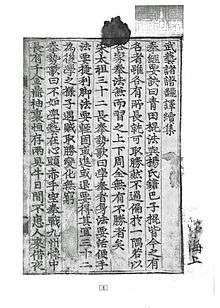 Muye Jebo - 1st page of commentary |
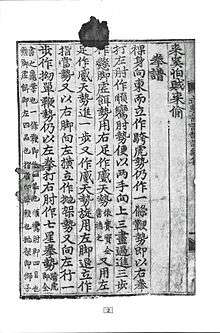 Muye Jebo - 2nd page of commentary |
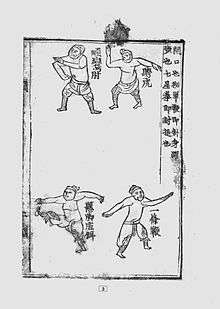 Muye Jebo - 3rd page of commentary and illustrations |
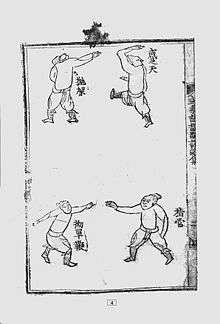 Muye Jebo - 4th page of commentary and illustrations |
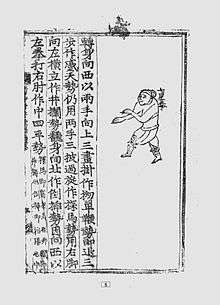 Muye Jebo - 5th page of commentary and illustrations |
 Muye Jebo - 6th page of commentary and illustrations |
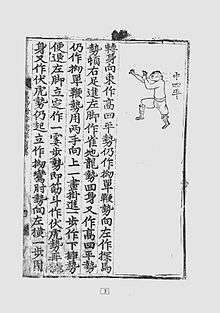 Muye Jebo - 7th page of commentary and illustrations |
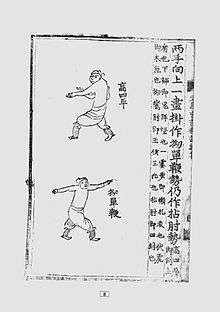 Muye Jebo - 8th page of commentary and illustrations |
 Muye Jebo - 9th page of commentary and illustrations |
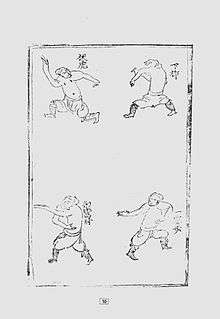 Muye Jebo - 10th page of commentary and illustrations |
 Muye Jebo - 11th page of commentary and illustrations |
 Muye Jebo - 12th page of commentary and illustrations |
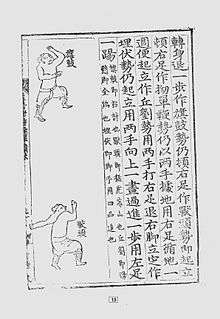 Muye Jebo - 13th page of commentary and illustrations |
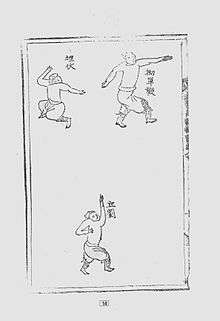 Muye Jebo - 14th page of commentary and illustrations |
 Muye Jebo - 15th page of commentary and illustrations |
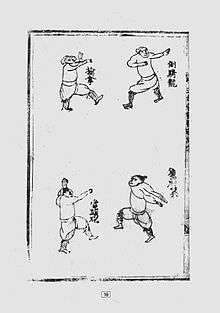 Muye Jebo - 16th page of commentary and illustrations |
 Muye Jebo - 17th page of commentary and illustrations |
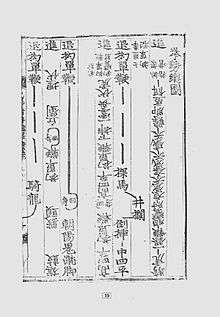 Muye Jebo - 19th page of commentary and illustrations |
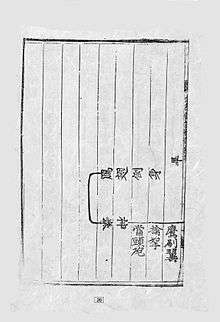 Muye Jebo - 20th page of commentary and illustrations |
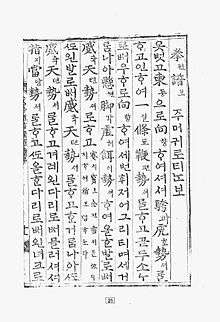 Muye Jebo - 21st page of commentary and illustrations |
Muye Dobo Tong Ji (“Comprehensive Illustrated Manual of Martial Arts”)
The following pages are taken from Book 4, Chapter 1 of the “Comprehensive Illustrated Manual of Martial Arts” published in 1795. It is possible to identify similar method titles and illustrations between this material and that of the Muye Jebo and General Qi's Boxing Canon. However, there are also a number of methods which do not bear the same name and may be methods introduced by the Korean administration of the time. In similar fashion one cannot be sure that a method bearing the same title as that designated by General Qi was executed in the same fashion or was even the same method. This manual retained use of the same images, making it reasonable that at least some of the methods were identified and functioned in the original manner identified by General Qi. However, once again, the Korean listing provides only the title and does not characterize the nature of the method. Since this list includes the total number of methods mentioned in the Muyedobotongji, each individual method is noted in bold representing 32 unique methods with repetition not found in General Qi's catalog. In addition the methods have been rearranged, to include a number of engagements between two individuals. In deference to the Neo-Confucian beliefs of the Korean nation at the time, these encounters between two individuals were intended to produce a kind of stalemate rather than the victory of one individual over another. The final two page also show the methods of the chapter organized into a continuous series or Form (K. Hyung) providing a kind of mnemonic device by which individuals were able to recall the requsite methods and, by extension, techniques associated with the methods.
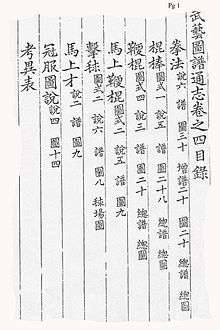
1. Scouting Horse Posture Tammase (탐 마 세) 探 馬 勢
2. Breaking Bird Elbow Yoranjuse (요 란 주 세) 拗 鸞 肘 勢
3. False Prey Posture Hyunkak Huheese (현 각 허 이 세) 顯 脚 虛 餌 勢
4. Docile Bird WingSunranjuse (순 란 주 세)順 鸞 肘 勢
5. Seven Star Fist Posture Chil Sung Kwonse ( 칠 성 권)七 星 拳
6. High Four levels Posture Kosapyeongse ( 고 사 평 세) 高 四 平 勢
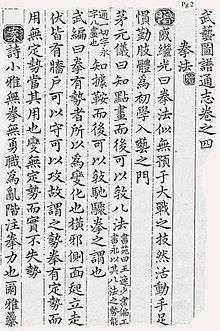
7. Throwing Posture Dosahpse (도 삽 세) 倒 揷 勢
8. Lightning-Step Posture Ilsahpbose (일 삽 보 세) 一 霎 步 勢
9. Single Whip Posture Yodanpyunse (요 단 편 세) 拗 單 鞭 勢
10. Prone Tiger Posture Bokhose (복 호 세) 伏 虎 勢
11. False Prey Posture Hyunkak Huheese (현 각 허 이 세) 顯 脚 虛 餌 勢
12. Pinning Posture Hasahpse

13. High Block Posture Dangdupose
14. Flag Beating Posture Kigose
15. Middle Four Levels Posture Joongsapyeongse (중 사 평 세) 中 四 平 勢
16. Throwing Posture Dosahpe
17. Falling and Riding the Dragon Posture Dokiryongse
18. Single Whip Posture Yodanpyunse (요 단 편 세) 拗 單 鞭 勢
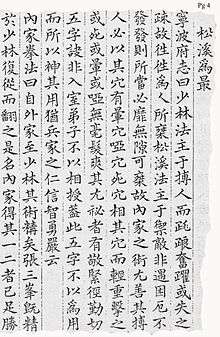
19. Ambushing Posture Maebokse
20. False Prey Posture Hyunkak Huheese (현 각 허 이 세) 顯 脚 虛 餌 勢
21. Pinning Posture Hasahpse
22. High Block Posture Dangdupose
23. Flag Beating Posture Kigose
24. Four levels Posture Kosapyeongse ( 고 사 평 세) 高 四 平 勢
25. Throwing Posture Dosahpse
26. Drizzling Walking Posture Ilsahpse
27. Single Whip Posture Yodanpyunse (요 단 편 세) 拗 單 鞭 勢
28. Five Flowers Winding Around the Body Posture Ohwa Junshinse
29. Goose Wing Posture Ahnshi Chukshinse
30. Straddling Tiger Posture Koahose
31. False Prey Posture Hyunkak Huheese (현 각 허 이 세) 顯 脚 虛 餌 勢
32. Focus and Winning Posture Kooyuse
33. Goose Wing Posture Ahnshi Chukshinse
34. Straddling Tiger Posture Koahose
35. False Prey Posture Hyunkak Huheese (현 각 허 이 세) 顯 脚 虛 餌 勢
36. Focus and Winning Posture Kooyuse
37. Goose Wing Posture Ahnshi Chukshinse
38. Straddling Tiger Posture Koahose
39. Prone Tiger Posture Bokhose
40. Arresting Posture Kumnase
41. Prone Tiger Posture Bokhose
42. Arresting Posture Kumnase
43. Throwing Shelf Posture Pogase
44. Picking Elbow Posture Jumjuse
45. Low Encountering Posture Nachaluichoolmun
46. Single Leg Throwing Posture Kumkye Doklip Jugi Jangtoi
47. Spring Railing Posture Jungranse
48. Ghost Kicking and leg striking Posture Kichuk Kakchange
49. Open Finger Attacking Posture Ji Dang Se
50. Beast Head Shield Posture Soodoose
51. Heavenly Fist Posture Shin kwon
52. Whipping Lunging Posture Iljo Pyunhweng Se
53. Dragon Prey Snatching Posture Jakjiryong Habantoibup
54. Slanting Hero Hand Posture Joyangsoo Pyunshin Bangtoi[3]
 4th Page of Commentary |
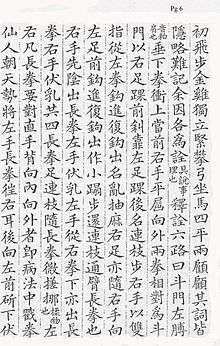 5th Page of Commentary |
 6th Page of Commentary |
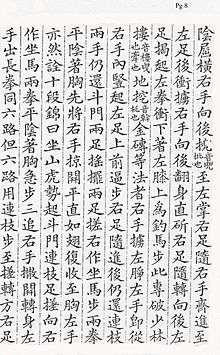 7th Page of Commentary |
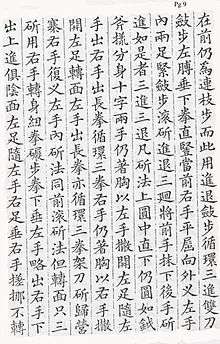 8th Page of Commentary |
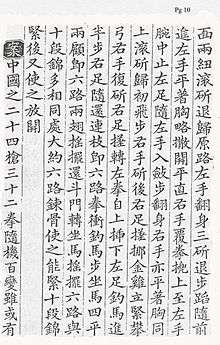 9th Page of Commentary |
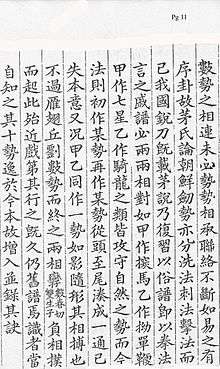 10th Page of Commentary |
 11th Page of Commentary and Illustrations |
 12th Page of Commentary and Illustrations |
 13th Page of Commentary and Illustrations |
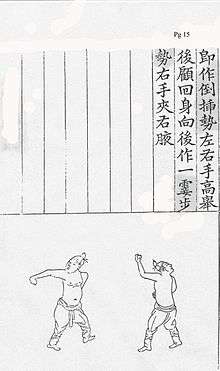 14th Page of Commentary and Illustrations |
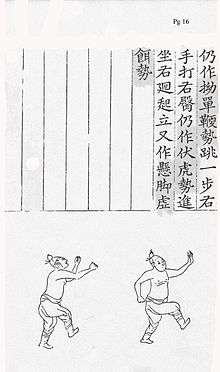 15th Page of Commentary and Illustrations |
 16th Page of Commentary and Illustrations |
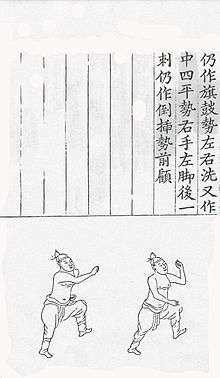 17th Page of Commentary and Illustrations |
 18th Page of Commentary and Illustrations |
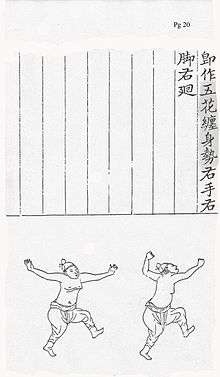 19th Page of Commentary and Illustrations |
 20th Page of Commentary and Illustrations |
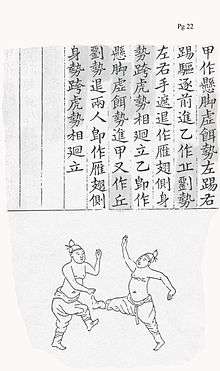 21st Page of Commentary and Illustrations |
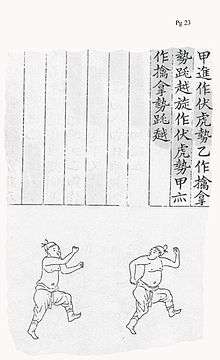 22nd Page of Commentary and Illustrations |
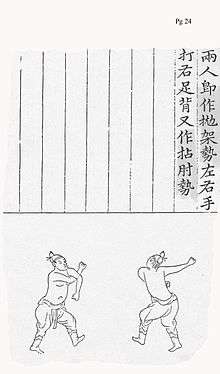 23rd Page of Commentary and Illustrations |
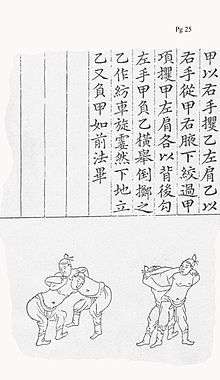 24th Page of Commentary and Illustrations |
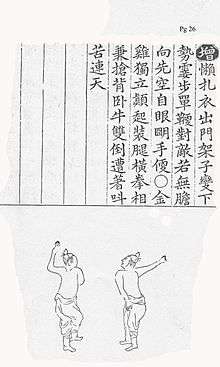 25th Page of Commentary and Illustrations |
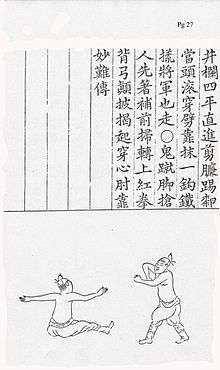 26th Page of Commentary and Illustrations |
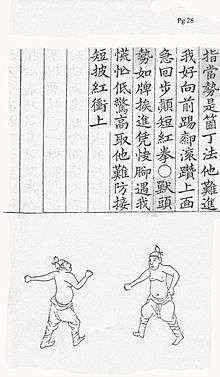 27th Page of Commentary and Illustrations |
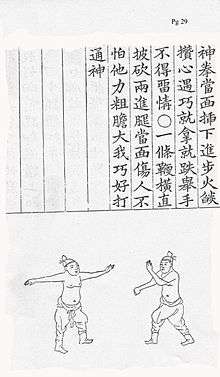 28th Page of Commentary and Illustrations |
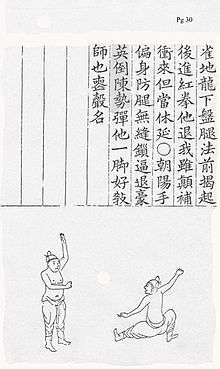 29th Page of Commentary and Illustrations |
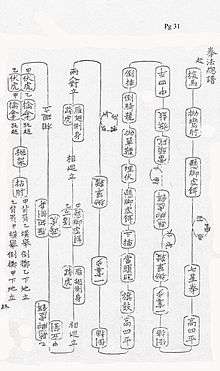 30th Page of Commentary and Illustrations |
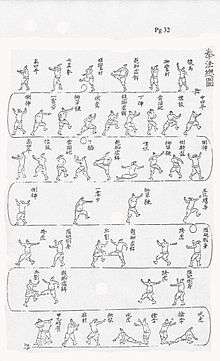 31st Page of Commentary and Illustrations |
Analysis of methods and applications
In his introduction to the 14th Chapter of his military training manual - Quanjing Jieyao Pian ("Chapter on the Fist Canon and the Essentials of Nimbleness") - General Qi coined the terms by which later practices organized their material: Striking (Ti), Kicking (Da), Wrestling (Shuai), and Submission (Na) as well as being the first to distinguish between Short Fist and Long Fist types of Boxing.[4] Though known for centuries before his time, most practices had been unique to a particular unit, or a particular geographic area from which conscripts were drawn. General Qi first organized his material along these four categories with the intention of developing a Military Science that would inter-relate to the other weapons and duties of the soldier. Further, General Qi identified the role of unarmed training by stipulating three outcomes. The first was Conditioning of the soldiers' body wherein the observation was made that "This craft does not really concern itself with military weapons, but acquiring excess strength is also something which those in the military field ought to practice". That said, General Qi went on to acknowledge that the relationship between the use of weapons and those skills of unarmed training ought not be discounted. ("In general the hand, staff, broadsword, spear....all proceed from barehanded techniques to train the body and the hands.") and is clearly the second intended outcome to this training. Lastly, a strong spirit through the cultivation of self-confidence is understood from the General's advocacy for matching his soldiers against one another. As stated towards the end of his introduction, "If you are afraid of your opponent then your skill is still shallow. If you are good at contests it must be that the art is refined. The ancients said, 'when the art is high, the peoples courage is great.' This is credible".[5]
Gwon Beop methods are very much an expression of the culture and circumstances in which they were used. Use of the famed "Mandarin Duck" formation as well as small unit tactics that followed, obviated the need to consider much beyond threats directly to the front and rear as the flanks of any one unit were secured by units to either side. In this way an adversary could be viewed, essentially as a matrix of nine squares consisting of a left, right and middle square at a high, middle and low level. In response to this matrix, a defender could respond with various combinations of an active or passive front hand, an active or passive rear hand as well as an active or passive front or rear foot. Similarly, a secondary matrix could be envisioned to the rear in the case that an adversary was able to make his way behind the formation. While an initial assessment might suggest an overwhelming number of options, experience soon demonstrates which method or combination of methods are the most efficient and effective in producing the desired outcome. In this way certain techniques came to be identified with certain circumstances, methods or postures and these were the determinations that were made by the training cadre. Regardless of the specific technique, illustrations and descriptions of the biomechanic being employed are commonly represented in General Qi's work at the moment at which the adversary is engaged.
Notes
- ↑
"Golden Cockerel stands on One Leg lowers and raises.
Feint with the leg and strike sideways with the fist.
Throw the opponent on his back with arms and legs in the air.
When the opponent encounters this technique, his cries will reach high heaven."
Source: Wile, Douglas Tai Chi's Ancestors Sweet Chi Press, 1999; pgs 18–35
References
- ↑ Handbook of Korea Korean Overseas Information Service, 2003; pg 57-58
- ↑ Kimm, He-young History of Korea and Hapkido Andrew Jackson College Press, 2001; pgs 52-58
- ↑ Sang H. Kim Muye Dobo Tongji Turtle press, Jan 2001; pgs 311-332
- ↑ Kung Fu Elements; WU Wen-chying, LIANG Shou-yu; Way of the Dragon Publ, 2001; pg 28
- ↑ "An English Translation of General QI Jiguangs' "Quanjing Jieyao Pian" (Chapter on the Fist Canon and Essentials of Nimbleness) from the "Ji Xiao Xin Shu" (New Treatise of Disciplined Service); Gyves, Clifford Michael; University of Arizona, 1993; pg. 33-37
Further reading
- Choe, Ki-nam Muye Bunyok Sokjib (1610) Republ in 1999 by Taegu Kwangyoksi: Kyemyong Taehakkyo Chulpanbu; ISBN 89-7585-179-6
- Kimm, He-young History of Korea and Hapkido Andrew Jackson College Press, 2001; ASIN: B0006OY7UE
- Kim, Sang H. Muye Dobo Tongji Turtle press, Jan 2001;ISBN 1-880336-53-7
- Wile, Douglas Tai Chi's Ancestors Sweet Chi Press, 1999;ISBN 0-912059-04-4